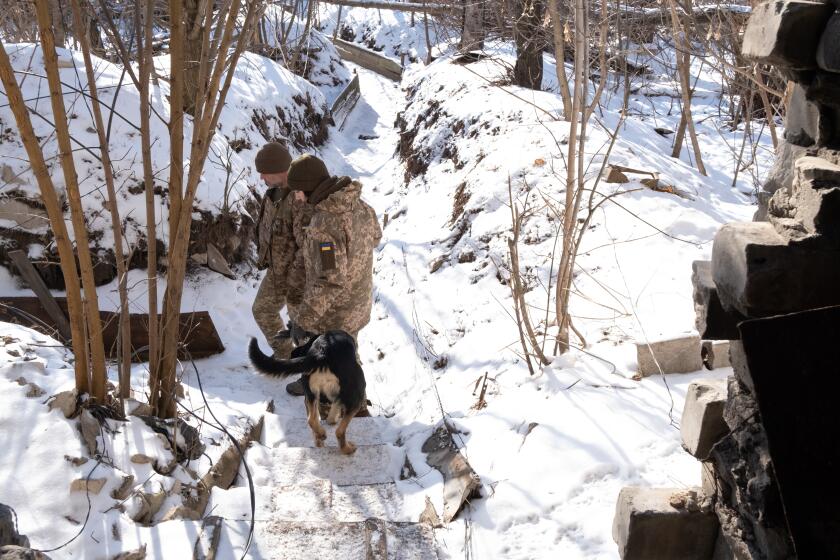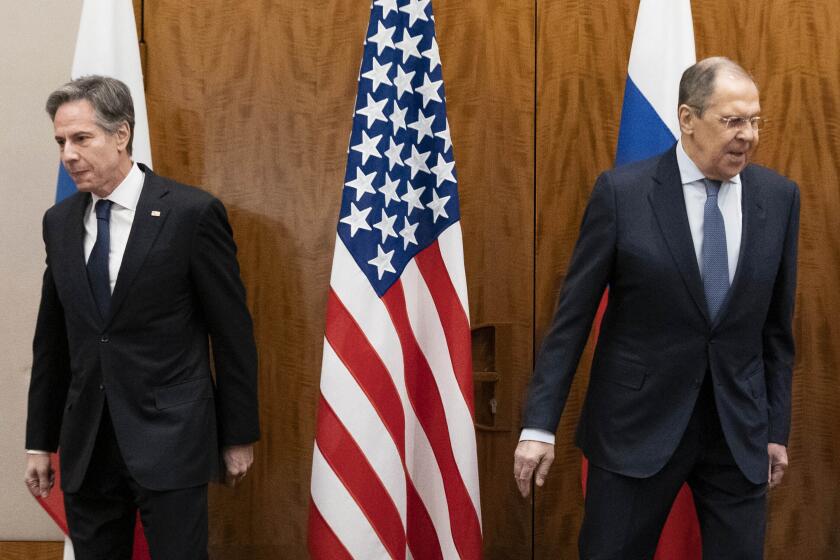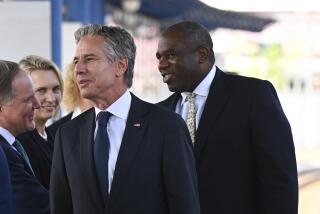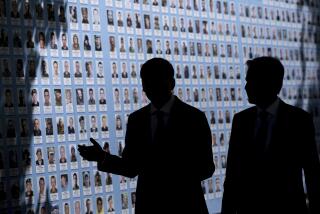U.S., NATO step up war footing in crisis over possible Russian invasion of Ukraine
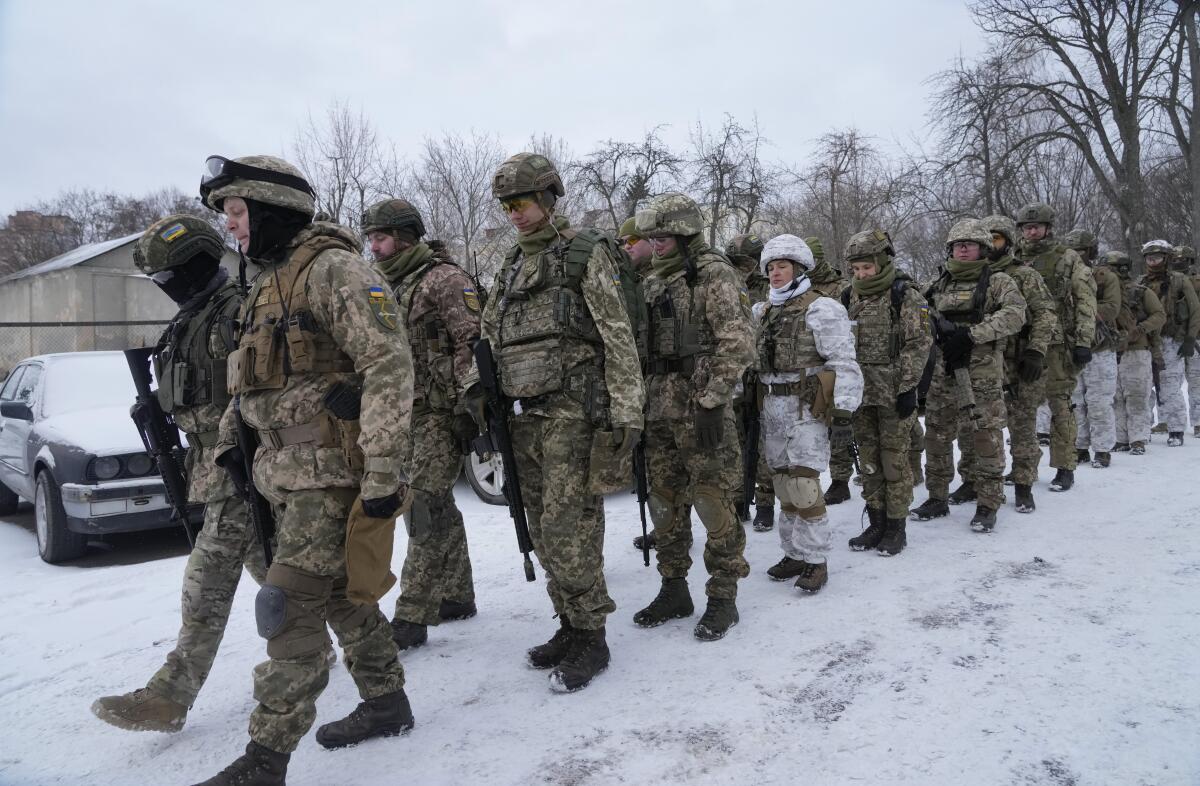
- Share via
WASHINGTON — With the crisis over a potential Russian invasion of Ukraine intensifying on Monday, U.S. officials placed thousands of troops on “high alert” and NATO took steps to position personnel and war machinery in Eastern Europe, further signs that a diplomatic solution to the standoff was nowhere within reach.
Biden administration officials said a final decision had not been made about whether to dispatch troops, but 8,500 U.S.-based soldiers and other personnel specializing in reconnaissance, intelligence, aviation and transportation were being placed on heightened readiness to be dispatched to Europe if needed.
President Biden has thus far ruled out putting U.S. troops in Ukraine but has signaled a willingness to use U.S. military personnel to bolster NATO forces if requested.
“This is about getting troops ready,” Pentagon spokesman John Kirby said. “It is very clear the Russians have no intentions right now of de-escalating.”
Slog of trench warfare in eastern Ukraine yields scenes reminiscent of World War I.
White House Press Secretary Jen Psaki declined to speculate on whether the “high alert” status signaled the imminent deployment of troops.
“We’ve never ruled out the option of providing additional assistance in advance of an invasion,” she told reporters. “So I wouldn’t say it’s a response to an abrupt moment. It’s a part of an ongoing contingency planning process.”
NATO, meanwhile, outlined plans for reinforcements in the East. Denmark is sending a frigate to the Baltic Sea and is set to deploy four F-16 fighter jets to Lithuania, while Spain, France and the Netherlands are sending or planning to send ships, fighter jets or troops to countries like Bulgaria and Romania.
“I welcome allies contributing additional forces to NATO,” said the transatlantic alliance’s secretary general, Jens Stoltenberg. “NATO will continue to take all necessary measures to protect and defend all allies, including by reinforcing the eastern part of the alliance.”
The troop actions followed a decision Sunday by U.S. officials to order families of U.S. personnel at the U.S. Embassy in Kyiv to leave the country. That announcement — matched Monday by Britain — set off panic among Ukrainians. A Ukrainian journalist at Monday’s State Department briefing in Washington took pains to remind a State Department spokesman that Washington did not extract its personnel during Ukraine’s 2014 ferociously deadly conflict with Russia.
The situation in Ukraine, a pro-West emerging democracy flanked on at least two sides by more than 100,000 Russian troops, dominated public and private conversation at the White House on Monday. Biden has said he believes Russia will invade the former Soviet Republic. Security experts say a Russian attack and its violent fallout are inevitable.
U.S. officials consistently insist, but with less and less optimism, that diplomacy is still on the table.
Russia and the United States held ‘frank’ talks Friday but failed to resolve deep differences over Ukraine, as the U.S. races to avert an invasion.
America’s top diplomats — Secretary of State Antony J. Blinken and his deputy Wendy R. Sherman — have spent much of the last two weeks in European capitals, including Kyiv, trying to build a united front against Moscow. They have also met with their Russian counterparts, but do not appear to have succeeded in easing tensions.
In the hopes of shoring up unity among allies, Biden and Blinken met again Monday, virtually, with European leaders to discuss ways to confront Russian aggression. Participants included the presidents or prime ministers of Poland, Britain, France, Italy and Germany.
The U.S. president and secretary of State pledged to “impose massive consequences and severe economic costs” on Russia for any “additional aggression” against Ukraine. One possible measure would be booting Russia from international banking transactions. While such an action would be devastating to Moscow, it would also hurt its European trade partners.
But some European governments, such as Germany, are reluctant to hit Russia very hard because of numerous business ties they maintain with Moscow.
Russian President Vladimir Putin says his nation’s military build-up is merely part of routine exercises, though he appears to be escalating the situation by moving troops into Belarus, an ally situated on Ukraine’s northern side, much closer to Kyiv than the larger Russian deployments to Ukraine’s east. North Atlantic Treaty Organization members Poland, Hungary and Romania sit on Ukraine’s western border.
Putin has blamed the crisis on the West, which he says is responsible for stoking tensions as part of its effort to dominate the former Soviet empire that he yearns to again have under Kremlin control.
His key demand in talks with U.S. and European officials is that Ukraine never be allowed to enter NATO. While Kyiv is still a long way from qualifying for NATO membership, the alliance refuses to change its “open door” policy whereby any nation is entitled to apply for membership.
Kremlin spokesman Dmitry Peskov on Monday blamed Western “hysteria” for inflaming tensions over Ukraine.
“It is generally laced with a huge amount of false information,” Peskov said.
For Ukraine and its president, Volodymyr Zelensky, however, the crisis appears to be existential. Backed by some U.S. lawmakers and former diplomats, he is urging more forceful U.S. and NATO actions now, before and as a real deterrent to a Russian invasion, rather than as punishment afterward.
“Strong Ukraine is key for European security,” he said Monday.
More to Read
Get the L.A. Times Politics newsletter
Deeply reported insights into legislation, politics and policy from Sacramento, Washington and beyond. In your inbox three times per week.
You may occasionally receive promotional content from the Los Angeles Times.
